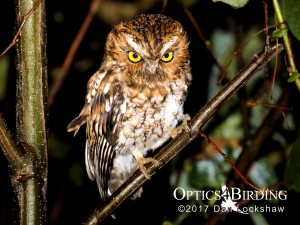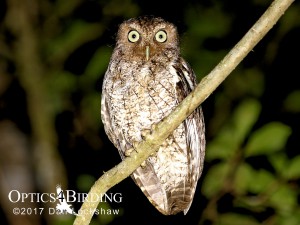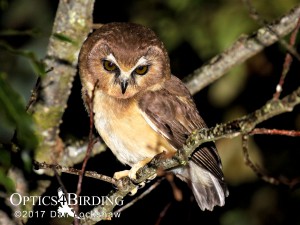
The highly sought after Unspotted Saw-whet Owl inhabits the cloud forest mostly above 8,000 feet in elevation. In this photo, light dew is visible on the owls head from the mist in the forest. In this photo, light dew is visible on the owls head from the mist in the forest.
After 15 years, I finally got brave enough to go back in search of the Chiapas owls. Chiapas is the southernmost state of Mexico that borders Guatemala. This was pretty much a mandatory destination to complete our sister owling.com website. There is no other state in Mexico with as many owl species as Chiapas. This area is also crucial to our current understanding of owl taxonomy. New divisions and more accurate classification of the owls are slowly becoming known and being clarified by science.
Chiapas is spectacular for wildlife and has an extraordinary history, but suffers from terrible pollution and horrific habitat destruction. While the natural wealth is immense, the population is poor, and traveling there can be dangerous. Having done this before, my plan was to mitigate risk, so I invited a friend and hired a guide. We documented nine species of owls in nine nights (video, recording, photograph, etc.) along with over a hundred eighty species of birds and mammals in the daytime. I will cover more of this in an upcoming article.
The Chiapas owls comprise of 19 different species. None of these species are specifically endemic to the state of Chiapas. Some of the owls have very small ranges. Chiapas or Guatemala may be the only reliably places to find these species. Remote areas of Guatemala are even more dangerous travel. Below is a list of the Chiapas owls. This list reflects our most current knowledge. The owls are not well studied; most species are at some level of threat, and Central America has a poor record for wildlife conservation.
Chiapas Owls Checklist
| STRIGIFORMES: Tytonidae | ||
| American Barn Owl | Tyto alba | |
| STRIGIFORMES: Strigidae | ||
| Flammulated Owl | Psiloscops flammeolus | |
| Pacific Screech Owl | Megascops cooperi | |
| Whiskered Screech Owl | Megascops trichopsis | |
| Bearded Screech Owl | Megascops barbarus | |
| Guatemalan Screech Owl | Megascops guatemalae | |
| Great Horned Owl | Bubo virginianus | |
| Mexican Wood Owl | Strix squamulata | |
| Black-and-white Owl | Ciccaba nigrolineata | |
| Fulvous Owl | Strix fulvescens | |
| Crested Owl | Lophostrix cristata | |
| Spectacled Owl | Pulsatrix perspicillata | |
| Guatemalan Pygmy-Owl | Glaucidium cobanense | |
| Central American Pygmy-Owl | Glaucidium griseiceps | |
| Ridgway’s Pygmy-Owl | Glaucidium brasilianum | |
| Burrowing Owl | Athene cunicularia | |
| Unspotted Saw-whet Owl | Aegolius ridgwayi | |
| Stygian Owl | Asio stygius | |
| Striped Owl | Asio clamator | |
Methodology
We had nine nights to search for the Chiapas owls. We prioritized our searches for the species that were hard to find in other places and those less well known to science. Unspotted Saw-whet Owl was our primary target for this trip. On previous trips to Chiapas and Costa Rica, I had missed getting photos of this species either by not getting close enough or not finding the owl at all. In four nights of searching for this owl, we managed to document two individuals. Both were high in the cloud forests above 8,000 feet in elevation. The real delight was the one that landed on our guide’s head! I missed that photo I am sorry to say.
Unspotted Saw-Whet Owl

Unspotted Saw-whet Owl in the cloud forests were sometimes very bold and sometimes very timid. Never a simple find, we spent 4 nights hearing them before we ever saw one.
The Unspotted Saw-whet Owl is considered critically endangered in Mexico. Scattered sightings of this owl have occurred in Guatemala, Nicaragua, Costa Rica, and Western Panama. The threats of deforestation are of major concern for this cute little owl. Since they live in scattered and remote high-elevation cloud forests, there are no accurate population estimates for this species. The dangers of destroying nocturnal species like this one are great. This is particularly true of species in third world countries with high population growth and density, where the forests are being destroyed for fuel and agriculture. This is exactly the case in Chiapas where air pollution from the burning and stripping of the forests is widely prevalent. The balance of nature depends on the nocturnal predator base. We know very little about the owls. Since we seldom see them they’re vulnerable to eradication.
Guatemalan Pygmy-Owl
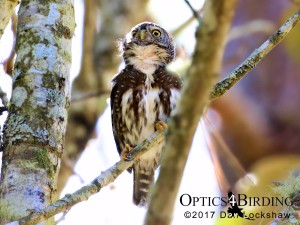
Guatemalan Pygmy-Owl comes from a recent division of Mountain Pygmy-Owl. Science is beginning to clarify both pygmy and screech-owls in Central America.
Next on our list of Chiapas owls was the newly-defined Guatemalan Pygmy-Owl. It has a very small range in Mexico and Guatemala and possibly also Nicaragua. Since this owl is resident at over 8,000 feet, it is also a high-elevation species. It is a small diurnal owl that is about the size of a sparrow. It is very difficult to find, observe, or photograph since it stays way up at the top of big trees in the dry forest canopy. Current research has proposed this division from the Mountain Pygmy-Owl based on geographic separation, DNA, and vocal differences. We agree and have followed this taxonomy on our owling.com website.
Bearded Screech-Owl
Bearded Screech-Owl was also high on our list of Chiapas owls. Finding this cute little screech-owl was fairly simple when compared to the other owls we had looked for. Although in previous trips into this region, I had found this species at lower elevations, it was also in the cloud forests where we were looking for the Unspotted Saw-whet Owl. In general, we sort of stumbled upon this owl while searching for the other Chiapas owls.
Bearded Screech-Owl occurs in both brown and red morphs which are about equally abundant. This owl has a very restricted range limited to Chiapas and Guatemala. It faces the same threats of deforestation and habitat loss as the Unspotted Saw-whet Owl does. The difference between the threats to these two owls is in range and density. The Unspotted Saw-whet Owl is solitary and has a territory which makes its population density very low. It has a larger range but a low density within that range. The Bearded Screech-Owl has a very small range but lives in a social collection or group. When you find these owls, there are several in an area.
Guatemalan Screech-Owl
The Guatemalan Screech-Owl is a species with an extensive range from Sonora in northwest Mexico and Tamaulipas in northeast Mexico to Nicaragua. I have heard this owl many times and taken pictures of it in the past. Its call is extremely ventriloquial making it almost impossible to find. It is also very timid in my experience. Our guide claimed this was a simple owl to find in the Naha area so it was an important species for us in finding the Chiapas owls. “Ha, ha, ha!” is what I must say to this. Yep, some people stumble upon this owl during the right time of year or place or moon phase or who the heck knows how, but reliably seeing this species is not easy. We went to and stayed in the Naha area twice before we finally got decent views and documentation.
Naha is near the Guatemalan border. We went here at the beginning of our trip in search of Guatemalan Screech-Owl although missed getting photos of the owl. We returned for photos at the ending of our journey. Determination pays off. Seeing this owl is not easy. We heard several of them on both visits. On our second trip to Naha we did finally get very good views, recordings, video, etc. of the species. The race of Guatemalan Screech-Owl found in the south has much heavier markings than the race found in the north of its range. The differences are dramatic and it was very interesting. The owl in the photo shown here was very obliging, so we also had the opportunity to take video. We have posted it on our owling.com website on the video tab of the Guatemalan Screech-Owl page.
Pacific Screech-Owl

Owls vary in both color and eye color. This particular individual had gorgeous yellow-orange colored eyes. This is the natural color of his eyes. (not Photoshopped)
Having been to Oaxaca in recent times to see the newly-defined Oaxaca Screech-Owl, that we wrote about here on our blog, it was important to get clear documentation of the Pacific Screech-Owl in Chiapas. The Oaxaca Screech-Owl was formerly lumped with the Pacific Screech-Owl. These two species are extremely different. Vocalizations are the first defining character of the owls since this is how they find each other at night. This, in turn, drives speciation. I had been to the Puerto Arista area previously and knew that Pacific Screech-Owl was common. I wanted at least some basic documentation of this owl, from this area, since I had limited time.

This individual is much lighter in color than the owl in the previous photo. It also has much more yellow colored eyes.
Not to get too off track here, the Oaxaca Screech-Owl, which has a very limited range along the Oaxaca coastline, at some point becomes Pacific Screech-Owl. The two species can be distinguished both visually and vocally. Since I had been to Oaxaca in recent times it was important to see the Pacific Screech-Owl right at the Oaxaca / Chiapas border. In a future trip, I will look along the southern coastline of Oaxaca and see where these two species divide and what happens in the mix if such an area exists.
The Dangers Ahead
Coastline property is high value real estate and in high demand. The Pacific Screech-Owl has a very narrow range along the coast from Chiapas to Costa Rica. This owl is facing some of the highest and immediate pressures to its habitat. Coastal development in Central America is putting real pressure on the small remaining native habitat. The changes to this area from when I was last here 15 years ago were frightening. I assumed this would be a simple owl to find and it was. Yet this was mostly because their habitat no longer existed. There were only a few places the owl could be. The increases in human population, and disappearance / destruction of the owls’ habitat was saddening. Also sadly demolished were my hopes for nice, clean coastal air.
Palenque
The Crested Owl and the Black-and-White Owl were next on our list of Chiapas owls. This would require going to the Caribbean side of Chiapas. The Palenque area is a good place look. To interject here, the ruins are spectacular. It is amazing that mankind could build such incredible structures here in the Americas so long ago (230BC – 790AD).
Ridgeway’s Pygmy-Owl
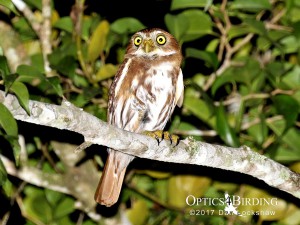
All the other small birds hate this owl because of those feet! If he wore shoes they would be a size “14”. Catching and eating other small birds is in this owl’s design.
Back to the Chiapas owls, after our sightseeing in the ruins we needed to get a room before searching for the owls at night. Directly down the road, we found a room for the night. As we arrived, some of the other guests, spotting our cameras, asked us what we were doing. We explained that we were there to photograph the Chiapas owls. Coincidentally, a Ridgeway’s Pygmy-Owl flew into the tree overhead. “Ah, listen” I said. When we showed them the owl in the trees overhead, the other hotel guests had complete surprise. This was certainly fortuitous timing. Since we knew the owl sounds we recognized that there was one very close by. It made for an interesting example of observation.
You may be asking “What is a Ridgeway’s Pygmy-Owl?”. Ferruginous Pygmy-Owl has been split. What used to be a Ferruginous Pygmy-Owl in North and Central America is now a Ridgeway’s Pygmy-Owl. This division is new. The name will become more commonly used when it becomes the standard in field guides. The split off owl species found in South America retained the Ferruginous Pygmy-Owl name. This is again an example of our growing knowledge of the owls and our general understanding of nature. Taxonomy becomes more precise as research clarifies the species. This is also another example of the concerns about the disappearance of wildlife before we even know what is disappearing. The biodiversity of our planet is in sharp decline and the owls are extremely vulnerable.
Crested Owl
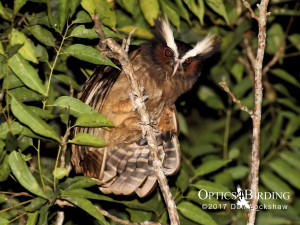
This owl has his wings partially open to make himself look larger. Crested Owls take this position as a defensive posture.
So again, back to the Chiapas owls. After settling in our room, we decided to check the local area around Palenque. Entry into the ruins at night have strong restrictions yet I know that Crested Owls are near the ruins at night. Required permits are mandatory for nocturnal entry, which we failed to get in advance. Our searches would only include the perimeter areas. We did find several Crested Owls so it was not a problem.
Mostly people see Crested Owl when they run across them on daytime roosts. As I speak to the guides in Central America, they often claim that seeing this species takes lots of patience. My last experiences at night with these owls in Costa Rica were very frustrating. The owls always stayed high in the trees, mostly out of view, but were vocal. They were extremely timid and we only saw them briefly when flying lower through the trees in the canopy. Although generally high in the canopy here, the Crested Owls several times came out into the open where we could clearly see them.
Black-and-White Owl
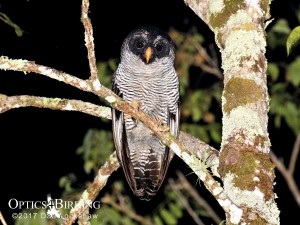
Black-and-White Owl is very visually distinctive in Central America. No other owl in Central America has the black and white colors. The Black-banded Owl of South America is the only similar species although it is smaller and has a different call.
While looking around the Palenque area in our search for the Chiapas owls we also found Black-and-White Owl. I expected this owl here having found them here before. This is generally a fairly bold species, in particular, early in the evening. It seems as the night progresses they become a little more cautious. Maybe they just become more alert and slightly more cautious of people. We found this species late at night and although visible, not like I have seen them in the past when I have had to back away to take a picture. This owl is unique in appearance. Both the Crested and Black-and-White Owls were a pleasure to see here.
Mexican Wood Owl
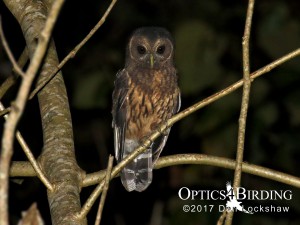
The southern race of Mexican Wood Owl has much darker markings than the northern race although this individual was very dark for even the southern race.
The last owl species of this trip was a Mexican Wood Owl. Again, if you are familiar with owls, you may be saying “What is a Mexican Wood Owl?”. The Mottled Owl has split into two species of owls. The nominate species in South America retains the common name. The IOU renamed Central American species as “Mexican Wood Owl”. As an analogy, both Volkswagen and Ferrari are cars with four wheels but they are very different. The owls are defined and identified by their primary call. If the call is different, it is a different species. Science and the guide books may take a while to catch up, but those of us in the field know this.
North of Arriaga, we had gone into the El Ocote forests to see if we could find the endangered and endemic Nava’s Wren (which we did find and photograph but that’s for another article). As it became dark several Mexican Wood Owls were present. This is the darker southern race of Mexican Wood Owl. Those in the north of Mexico are much lighter in color and markings. This area is right where the dividing line between these two races of Mexican Wood Owl occurs. Interestingly, we have seen the northern race of this species in Oaxaca in areas that are actually further south than El Ocote. This is generally a fairly bold and aggressive owl. It is very diverse in diet and habitat. Mexican Wood Owl is a very interesting owl that is quite common in Mexico and Central America.
Conclusion
We saw nine species of owls in our short visit to Chiapas. Their taxonomy will become clearer as we know more about them. Mankind is accountable for what we do to our planet. We can destroy the owls without it being apparent. To protect nature we need to be aware of it. I am sorry to say that so much of what we saw may disappear. Our oceans, land, and air cannot sustain nature at the rate we are blindly polluting and overpopulating. We live in a magical amazingly biodiverse planet and there is as yet no real way for us to get anywhere else in the
This owl has his wings partially open to make himself look larger. Crested Owls take this position as a defensive posture.
Crested Owls take this position as a defensive posture.

